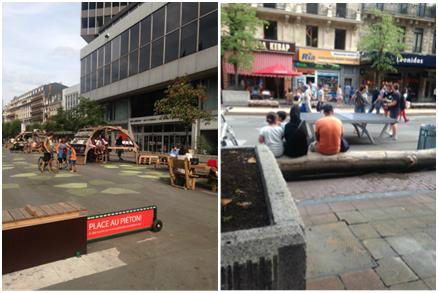 |
| Image credit: CarriAyne Jone, (Head of Science and Innovation, British Consulate-General, Atlanta) |
In December 2017 I was invited to take part in the Metro Lab Annual Summit, taking place in Georgia Tech in the United States. I thought it worthwhile to share a few of my own thoughts about the meeting and what can be drawn from the experience.
The MetroLab Network includes 41 cities and 55 universities within the United States that have formed city-university partnerships that focus on research, development and deployment projects to offer solutions to many of the challenges facing urban areas. These allow decision makers and researchers to work together within their cities to achieve better urban living, while being able to share best practice from each other’s experiences.
The visit was facilitated by the UK Science and Innovation Network, part of the Foreign and Commonwealth Office who provide opportunities for international collaboration. As well as delegates from the University of Bristol and Bristol City Council, we shared the visit with delegates from Glasgow and Strathclyde and from Innovate UK. Bristol has been designated as the UKs ‘smartest city’ according the smart city index commissioned by Huawei UK. A number of current innovations at Bristol are helping to develop the smart city capability including Bristol is Open, a joint venture between the city and university providing a digital infrastructure; and the Digital Health strategy (including IRC SPHERE ) that utilises sensing technology to facilitate healthier living. My own future work plans fit into this agenda, as I am trialling air quality and meteorological sensors that will help inform when and where I can run my gas tracer and aerosol measurement experimental campaigns.
In the morning of the day before the Summit, our delegation was introduced to the Consulate General and staff in their Atlanta office. Afterwards, we visited Southface, a company that promotes sustainable development and green building. Their offices included buildings designed to be exemplars of the type of technologies that they promote. I look forward to finding out more on some of the work they are doing in the monitoring of pollutants indoors from outdoors. After this visit we attended the launch of the Smart city and data-driven energy policy program, within which presentations were given on how a city could increase energy efficiencies, and the net gains that could be achieved.
The first day of the summit was held in the Georgia Institute of Technology Historic Academy of Medicine. The sessions included round table discussions from civic leaders, including mayors and chief technology/data/information officers (or similar variations of that title) about the challenges facing cities in the future, and how technologies can be used to address them, particularly in the gathering of data. Hearing civil leaders emphasising their commitment to action on climate change and public health independently of national policy was an encouragement to me.
Throughout both days, a number of research and development projects were highlighted that showed the benefit of smart technologies. One such technology was Numina, demonstrated in Jacksonville, which tracked traffic, bike and pedestrian movements so that cities have a better idea of what is happening on their streets. An 18 mile stretch of highway near Georgia has been turned into a living lab known as the Ray C Anderson memorial highway (The Ray) incorporating a driveable solar road surface, EV charge points and tyre safety checks. Another presentation described an ambitious attempt to link Portland, Seattle and Vancouver in the larger ‘megapolitan’ region of Cascadia, which would provide better management of transport over the area.
On the second day, there were, among other things, discussions on data privacy and an update on the Array of Things. The Array of Things is a project by Argonne Labs and Chicago University that is building a platform by which an instrumented ‘node’ can be connected to an urban network, collecting environmental sensing data which could include air quality, traffic and meteorology. These are currently being trialled in Chicago and will soon be sent to participating partner cities, including Bristol.
In the afternoon it was my privilege to participate in a panel discussion on Air Quality Sensing in Smart Cities, where I provided the perspective of a researcher in urban meteorology and pollution dynamics who is attempting to use the Bristol is Open smart city technology to assist with my research. The other panel members were Vincent McInally from Glasgow City Council who provided his experiences addressing air quality in Glasgow, including maintaining air quality measurement networks in the city, and Don DuRousseau from DWU, Washington DC who has many years experience in real-time systems, cybersecurity and informatics and has worked to set up high speed connectivity in many MetroLab partners.
The discussion included concerns about low-cost, (or low-accuracy as Vincent suggested we call them) sensors in reflecting true values of pollution in the city, and whether we can use the higher specification instrumentation to validate their usage and the related discussion on sensor placement and temporal variability or their output. The dangers of false positives, in particular from citizen sensing initiatives, was brought up in relation to these reliability concerns, and how these limitations can be communicated with the public such that the information can be better interpreted. There is certainly value in giving real time air quality information to the public, and it is something I have discussed with many project partners within Bristol, but this leads to the dilemma of whether the data needs to be filtered in some way so as to account for the errors, or whether the public have a right to all the data as a matter of course. The discussion also included some examples of how sensor measurements, and other initiatives, have been used to make a positive difference in city life.
Overall, the experience was a positive one for our delegation and shows the value of both using new technologies to affect positive change in city life, it underlined the merits in strong communication and collaboration between city leadership and the universities, and furthermore, showed the value of civic leaders and university academics from different cities coming together to share each other’s experiences of implementing smart cities. It may be time to consider how those cities in the UK could also bring together our own experiences.
 |
| James Matthews |











